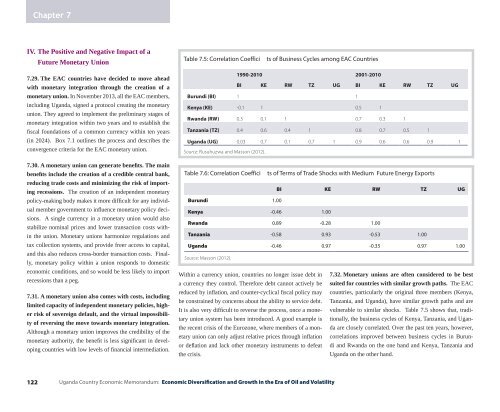Economic Diversification and Growth
71mK301zeG0
71mK301zeG0
You also want an ePaper? Increase the reach of your titles
YUMPU automatically turns print PDFs into web optimized ePapers that Google loves.
Chapter 7<br />
IV. The Positive <strong>and</strong> Negative Impact of a<br />
Future Monetary Union<br />
Table 7.5: Correlation Coeffici<br />
ts of Business Cycles among EAC Countries<br />
7.29. The EAC countries have decided to move ahead<br />
with monetary integration through the creation of a<br />
monetary union. In November 2013, all the EAC members,<br />
including Ug<strong>and</strong>a, signed a protocol creating the monetary<br />
union. They agreed to implement the preliminary stages of<br />
monetary integration within two years <strong>and</strong> to establish the<br />
fiscal foundations of a common currency within ten years<br />
(in 2024). Box 7.1 outlines the process <strong>and</strong> describes the<br />
convergence criteria for the EAC monetary union.<br />
7.30. A monetary union can generate benefits. The main<br />
benefits include the creation of a credible central bank,<br />
reducing trade costs <strong>and</strong> minimizing the risk of importing<br />
recessions. The creation of an independent monetary<br />
policy-making body makes it more difficult for any individual<br />
member government to influence monetary policy decisions.<br />
A single currency in a monetary union would also<br />
stabilize nominal prices <strong>and</strong> lower transaction costs within<br />
the union. Monetary unions harmonize regulations <strong>and</strong><br />
tax collection systems, <strong>and</strong> provide freer access to capital,<br />
<strong>and</strong> this also reduces cross-border transaction costs. Finally,<br />
monetary policy within a union responds to domestic<br />
economic conditions, <strong>and</strong> so would be less likely to import<br />
recessions than a peg.<br />
7.31. A monetary union also comes with costs, including<br />
limited capacity of independent monetary policies, higher<br />
risk of sovereign default, <strong>and</strong> the virtual impossibility<br />
of reversing the move towards monetary integration.<br />
Although a monetary union improves the credibility of the<br />
monetary authority, the benefit is less significant in developing<br />
countries with low levels of financial intermediation.<br />
1990-2010 2001-2010<br />
BI KE RW TZ UG BI KE RW TZ UG<br />
Burundi (BI) 1 1<br />
Kenya (KE) -0.1 1 0.5 1<br />
Rw<strong>and</strong>a (RW) 0.3 0.1 1 0.7 0.3 1<br />
Tanzania (TZ) 0.4 0.6 0.4 1 0.8 0.7 0.5 1<br />
Ug<strong>and</strong>a (UG) 0.03 0.7 0.1 0.7 1 0.9 0.6 0.6 0.9 1<br />
Source: Rusuhuzwa <strong>and</strong> Masson (2012).<br />
Table 7.6: Correlation Coeffici ts of Terms of Trade Shocks with Medium Future Energy Exports<br />
BI KE RW TZ UG<br />
Burundi 1.00<br />
Kenya -0.46 1.00<br />
Rw<strong>and</strong>a 0.89 -0.28 1.00<br />
Tanzania -0.58 0.93 -0.53 1.00<br />
Ug<strong>and</strong>a -0.46 0.97 -0.35 0.97 1.00<br />
Source: Masson (2012).<br />
Within a currency union, countries no longer issue debt in<br />
a currency they control. Therefore debt cannot actively be<br />
reduced by inflation, <strong>and</strong> counter-cyclical fiscal policy may<br />
be constrained by concerns about the ability to service debt.<br />
It is also very difficult to reverse the process, once a monetary<br />
union system has been introduced. A good example is<br />
the recent crisis of the Eurozone, where members of a monetary<br />
union can only adjust relative prices through inflation<br />
or deflation <strong>and</strong> lack other monetary instruments to defeat<br />
the crisis.<br />
7.32. Monetary unions are often considered to be best<br />
suited for countries with similar growth paths. The EAC<br />
countries, particularly the original three members (Kenya,<br />
Tanzania, <strong>and</strong> Ug<strong>and</strong>a), have similar growth paths <strong>and</strong> are<br />
vulnerable to similar shocks. Table 7.5 shows that, traditionally,<br />
the business cycles of Kenya, Tanzania, <strong>and</strong> Ug<strong>and</strong>a<br />
are closely correlated. Over the past ten years, however,<br />
correlations improved between business cycles in Burundi<br />
<strong>and</strong> Rw<strong>and</strong>a on the one h<strong>and</strong> <strong>and</strong> Kenya, Tanzania <strong>and</strong><br />
Ug<strong>and</strong>a on the other h<strong>and</strong>.<br />
122<br />
Ug<strong>and</strong>a Country <strong>Economic</strong> Memor<strong>and</strong>um: <strong>Economic</strong> <strong>Diversification</strong> <strong>and</strong> <strong>Growth</strong> in the Era of Oil <strong>and</strong> Volatility


